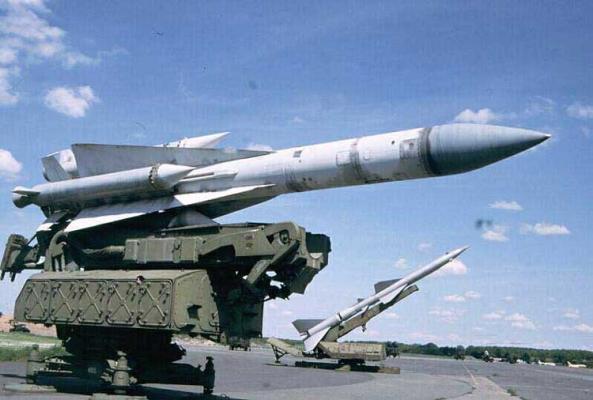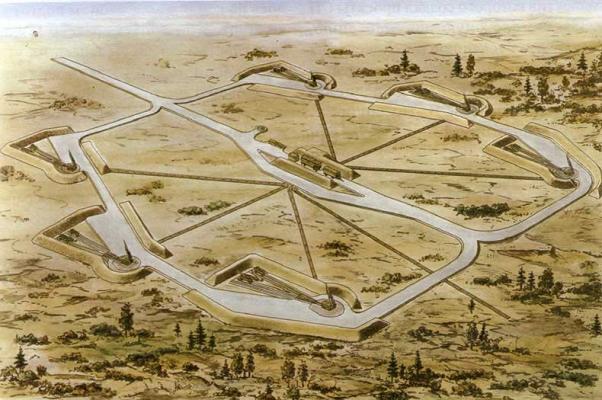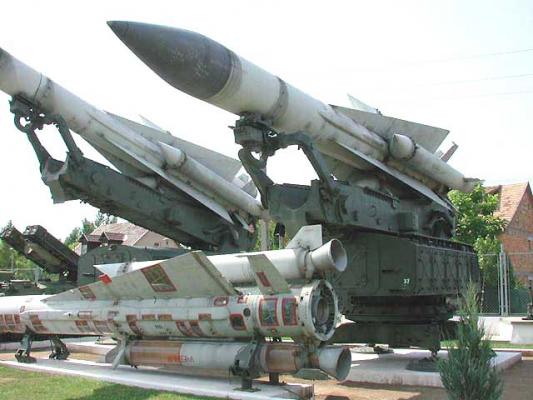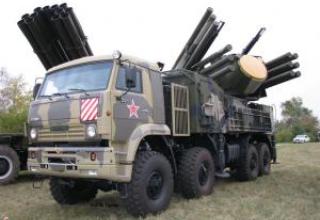All-weather long-range anti-aircraft missile system S-200 is designed to combat modern and advanced aircraft, air command posts, jammers and other manned and unmanned aerial attacks at altitudes from 300 m to 40 km, flying at speeds up to 4300 km / h, at ranges up to 300 km under conditions of intensive radio interaction.
The development of a long-range anti-aircraft missile system was started at the Central Design Bureau "Almaz" in 1958, under the index S-200A (cipher "Angara") the system was adopted by the air defense forces of the country in 1967. Virtually all major objects of the country were under its protection. Later the S-200 system was repeatedly upgraded: in 1970 - S-200B (cipher "Vega") and in 1975 - S-200D (cipher "Dubna"). During the upgrades the range of fire and the height of target engagement were significantly increased. The modified 5B28M missile with a long range and the possibility of firing at receding targets "inhalation", as well as work in conditions of active interference was introduced into the S-200D system. The 5B21, 5B28M, 5B28M anti-aircraft missiles, which are part of these systems, were developed by the Design Bureau-2 of MAP (Fakel ICBM) under the supervision of General Designer P.D. Grushin.., the detection and guidance system in SKB-1 "Almaz" (General Designer Alexander Andreyevich Raspletin - the founder of the Soviet school on the development of guided anti-aircraft missile weapons, in the 50's and 60's of the twentieth century, who carried out scientific and technical guidance for the development of anti-aircraft missile systems and systems S-25, S-75, S-125, S-200 and their modifications, as well as work on the development of an aerospace defense system), 5P72B launchers - in the Design Bureau of Special Machine Building.
The S-200V SAM system has been supplied from the early 1980s under the S-200VE Vega-E index to the GDR, Poland, Czechoslovakia, Bulgaria, Hungary, DPRK, Libya and Syria. In the early 1990s, the C-200BE complex was acquired by Iran. The export version of the system differed from S-200V by the changed composition of the PU equipment and control cabin.
In 1989-1990, the S-200V system was upgraded in order to create a "Removed Anti-aircraft Missile Battery" (VZRB) designed to launch missiles at targets accompanied by the ROC radar when the starting position was removed to a distance of 140 km. An intermediate conduit cabin was provided for communication with the command post of the TCDB. Additional requirements were made for TCDD to reduce the time of deployment from a camping position, to replace part of the equipment, to reduce the number of cable links, etc. However, there was no further practical continuation of the TCDD work.
In the west, the facility was designated SA-5 "Gammon".
Composition:
SAM S-200B is a single-channel transported system, placed on trailers and semi-trailers.
Composition of SAM system S-200V:
- System-wide tools:
- control and target designation center K-9M
- 5E97 diesel power plant
- distribution cabin K21M
- control tower K7
- Anti-aircraft missile division
- K-1B antenna post with 5H62B target illumination radar (see photo in combat position, in hiking position)
- hardware cabin K-2B (see photo in camping position, inside)
- launch booth K-3B
- distribution cabin K21M
- 5E97 diesel power plant
- starting position 5Zh51B (5Zh51) of the composition:
The 5Zh51B and 5Zh51 launch positions for the C-200B and C-200 systems, respectively, were developed by the Special Machine Building Design Bureau (Leningrad) and are designed for the prelaunch preparation and launch of 5B21B and 5B21A missiles. The launch positions were a system of launch pads for PU and ZM (charging machine) with a central pad for the launch preparation cabin, power station and a road system providing automatic missile delivery and charging of PU at a safe distance. Besides, the documentation for technical position (TP) 5Zh61 was developed, which was an integral part of the S-200 and S-200V anti-aircraft missile systems and was intended for storage of 5B21B and 5B21A missiles, their preparation for combat use and replenishment by missiles of the firing complex launch positions. The TA complex consisted of several dozens of machines and devices, providing all the work during the operation of the missiles.
The complex of equipment of the starting position included 5P72, 5P72B, 5P72B launchers, which were designed for prelaunch preparation, guidance and launch of missiles, 5Yu24 charging machine, designed for automatic charging of PU (see photo), a number of machines of technical position - road train 5T53 (5T53M), transport and loading machine (TPM) 5T83 (5T83M), transport charging machine (TZM) 5T82 (5T82M), mechanized rack 5YA83 and other machines.
The technical position assembled and deployed at the Sary-Chagan test site for pilot testing, provided joint testing of the C-200 system in 1964-1966.
PU 5P72 was a very complex automated machine and provided the prelaunch preparation, guidance and launch of the rocket. PU is equipped with an electric drive of the azimuth guidance mechanism, which allows for 35 seconds to move to 179 ° boom with the rocket, electro-hydraulic drive lifting mechanism, which raised the oscillating part with the rocket for 35 seconds to an elevation angle of 48 °, and electro-hydraulic drive mechanism of electric air-connector. The PU mechanisms operation is controlled by commands from the launch preparation cabin. After starting the rocket PU automatically docked to one of the two charging machines 5Yu24, which had a rocket, and in automatic mode was charged.
Charging machine 5Yu24 was a frame on the rail track with front and rear supports for the rocket, mechanisms and drives for the movement of the gear on rails, clutch mechanisms with PU 5P72 and the rocket board, providing an automatic cycle of charging, including access to the PU and return to the starting position. The frame with devices was supported by biaxial bogies.
In 1981, according to the CM Resolution No.277-85 of 16.03.81, the KBSM under the supervision of Chief Designer N.A. Trofimov initiated the development of the 5Zh51D launch vehicle and 5Zh61D technical positions, 5P72D launch vehicle and other long-range C-200D (Dubna) system equipment with improved tactical and technical characteristics. The starting position (SP) 5Zh51D consisted of six 5P72D PU, twelve 5Yu24M ZM, the KZD control cabin, combined into a firing channel. The power supply was provided by a diesel power plant.
The joint venture was equipped with prefabricated foundations for PU, rail tracks for gear and included a platform for cab and diesel power plant. The joint venture funds are transported. Deployment time - from march 24 hours. PU 5P72D with a constant position of the oscillating part at launch, tracking the electric drive of azimuth guidance, provided remote automatic prelaunch, target tracking and launch of the missile. Automated charging (discharging) of the PU was carried out with ZM 5Yu24M for a minimum time. It was also provided semi-automatic charging by means of TZM 5T82M from TP 5Zh61D. The starting position, starting installation, has undergone a number of changes to ensure a time-densed schedule of pre-start preparation, firing in the "overtaking", interference immunity. The task of significant reduction of maintenance volume and increase of its frequency has been solved. Most of the equipment, including the equipment of the launch automation, has been reworked and replaced.
Technical Position (TP) 5Zh61D is intended for storage, preparation for combat use and replenishment of 5B28M missiles of launch positions. The TP is a technological flow providing assembly of missiles, their equipment, control, fueling and oxidizer, transportation of finally assembled missiles to the JV. When the modernized 5B28M missile was introduced, some of the equipment of technical position 5Zh61D was subjected to structural rework, as 5B28M missile changed its weight and center of gravity and received an increased layer of heat protection coating.
The design documentation for JV 5Zh51D, TP 5Zh61D, PU 5P72D and other means was developed in 1981-1983. The Bolshevik plant in Leningrad produced prototypes of PU 5P72D for docking with joint venture facilities, development of a firing channel and launching of 5B28M (5B28, 5B21A) missiles at the Sary-Shagan range. Complex factory and state tests of JV 5Zh51D and TP 5Zh61D, conducted in 1980-1983 at the Sary-Shagan range (Sq. 7,35), have yielded positive results, confirmed compliance with the requirements of the TOR, and the JV and TP were recommended for acceptance into operation. Series production of PU 5P72D was carried out at Kiev plant "Bolshevik". and 5Yu24M charging machine - at Donetsk plant "Tochmash".
Target illumination radar (ROC) 5H62V is a high potential continuous radiation radar station. It accompanies the target, produces information for launching the missile, illuminates targets in the process of homing the missile. Construction of the ROC using continuous probing of the target by a monochromatic signal and, accordingly, Doppler filtering of echo signals provided the resolution (selection) of targets by speed, and the introduction of phase - code manipulation of the monochromatic signal - by range. Thus, there are two main modes of target illumination radar operation - MXI (monochromatic radiation) and FCM (phasocode manipulation). If the mode of MXI is applied, the air object of the ROC is escorted by three coordinates (angle of position - it is the same as the approximate target height - azimuth, speed), and the FCM - by four coordinates (to the listed coordinates added range). In the MHI mode on the indicator screens in the control cabin of SAM C-200 marks from targets look like glowing strips from the top to bottom edge of the screen. When switching to the FCM mode, the operator carries out the so-called sampling of ambiguity in range (which requires significant time), the signal on the screens takes the "normal" form of "rolled up signal" and there is an opportunity to accurately determine the distance to the target. This operation usually takes up to thirty seconds and is not applied when shooting at small distances, because the choice of the ambiguity in range and time of the target stay in the launch area - the value of one order.
Anti-aircraft guided missile 5B28 system C-200V two-stage, made by the normal aerodynamic scheme, with four triangle wings of large elongation. The first stage consists of four solid-fuel accelerators installed on the marching stage between the wings... The marching stage is equipped with a liquid two-component rocket engine 5D67 with a pumping system for feeding fuel components into the engine. Structurally, the marching stage consists of a number of compartments, which are located semi-active radar homing head, units of onboard equipment, shrapnel and high-explosive combat unit with a safety mechanism, tanks with fuel components, liquid rocket engine, rocket steering units. Launch of the rocket - inclined, with a constant elevation angle, with the launcher, guided by the azimuth. Shrapnel-flagged combat unit with ready hitting elements - 37 thousand pieces weighing 3-5g. When detonating a combat unit, the angle of flight of shrapnel is 120°, which in most cases leads to a guaranteed defeat of an air target.
The missile's flight control and target guidance is provided by a semi-active homing radar head (HID) mounted on the missile. For narrow-band filtering of echo signals in the receiving device of the CNS must have a reference signal - continuous monochromatic oscillation, which required the creation of an autonomous RF heterodyne on board the missile.
Prelaunch preparation of the rocket, includes:
- data transmission from the ROC to the starting position;
- Adjustment of the CNS (HF-heterodyne) for the carrier frequency of the RTC sound signal;
- installation of SOS antennas in the direction of the target, and their systems of automatic target tracking by range and speed - to the range and speed of the target;
- putting the CNS in the automatic tracking mode.
The start was then followed by automatic tracking of the CNS target. Ready to fire time - 1.5 min. If there is no signal from the target within five seconds, which is provided by the light from the ROC, the missile's homing head independently includes a search by speed. First, it searches for a target in a narrow range, then after five scans in a narrow range goes to 30 kilohertz wide range. If the radar's illumination of the target is resumed, the CNS finds the target, captures the target and further homing. If the CLO, after all these search methods, never found the target and did not re-capture it, the command "maximum up" is given to the rocket rudder. The missile goes into the upper atmosphere to avoid hitting ground targets and detonates the warhead there.
In the SAM S-200 for the first time there was a digital computer - Computer Center "Flame", which was tasked with exchanging command and coordinate information with different control and before the launch task. Combat work of S-200V SAM is provided by control means 83M6, automated systems "Senezh-M", "Baikal-M". Combination of several single-purpose SAMs with a common command post made it easier to control the system from a higher control level, it made it possible to organize interaction of SAMs to concentrate their fire on one or distribute them to different targets.
S-200 SAMs can be operated in different climatic conditions.
Characteristics:
| Feature | С-200А | С-200V | С-200D |
| Number of channels per target | 1 | 1 | 1 |
| Number of channels by missile | 2 | 2 | 2 |
| Range, km | 17-180 | 17-240 | 17-300 |
| Target flight altitude, km | 0.5-40 | 0.5-40 | 0.3-40 |
| The length of the rocket, mm | 10600 | 10800 | 10800 |
| Rocket caliber (marching stage), mm | 860 | 860 | 860 |
| Missile launch weight, kg | - | 7100 | 8000 |
| Weight BC, kg | 217 | 217 | 217 |
| Probability of hitting the target | 0.45-0.98 | 0.66-0.99 | 0.72-0.99 |
Testing:
The first combat use of the S-200 SAM system took place in 1982 in Syria, where at a distance of 190 km the E-2C "Hawkeye" DRLO was shot down, after which the American aircraft carrier fleet withdrew from the Lebanese coast. The Libyan S-200 complexes took part in repulsing an attack by American FB-111 bombers and possibly shot down one bomber.
On the basis of the 5B28 anti-aircraft missile of the S-200B complex a hypersonic flying laboratory "Cold" has been created to test hypersonic direct-flow air jet engines. The choice of this missile was based on the fact that the parameters of its flight path were close to those required for flight tests of the Hyper-Sonic Propulsion System. It was also considered important that the missile had been decommissioned and its cost was low. The missile's combat unit was replaced by the head compartments of the GLL "Kholod", which housed the flight control system, a liquid hydrogen tank with displacement system, a hydrogen flow control system with measuring devices and, finally, the experimental HPVRD E-57 of axially symmetric configuration.
Sources:
- "Зенитная ракетная система большой дальности С-200ВЭ". Рекламный проспект
- SA-5 AA Missile system (http://www.medianetjapan.com)
- ЗРС С-200 (НПО "Алмаз")
- Зенитный ракетный комплекс большой дальности С-200 (SA-5 Gammon)
- А. Маначинский "Осторожно! В акватории шальные ракеты", Человек и закон №9, ноябрь 2001
- «Холод» гиперзвуковая летающая лаборатория
- http://www.s200-wega.de
- "КБ специального машиностроения: От артиллерийских систем до стартовых комплексов" (под редакцией Ушакова В.С.) .СПб, 2004.
- Китов В.А. Выдающаяся роль первой советской серийной ЭВМ "Стрела" в деле укрепления обороноспособности страны // Институт истории естествознания и техники им. С.И. Вавилова. Годичная научная конференция (2013). Т.2: История химико-биологических наук. История наук о земле. Проблемы экологии. История техники и технических наук. - М.: ЛЕНАНД, 2013. - С. 352.








